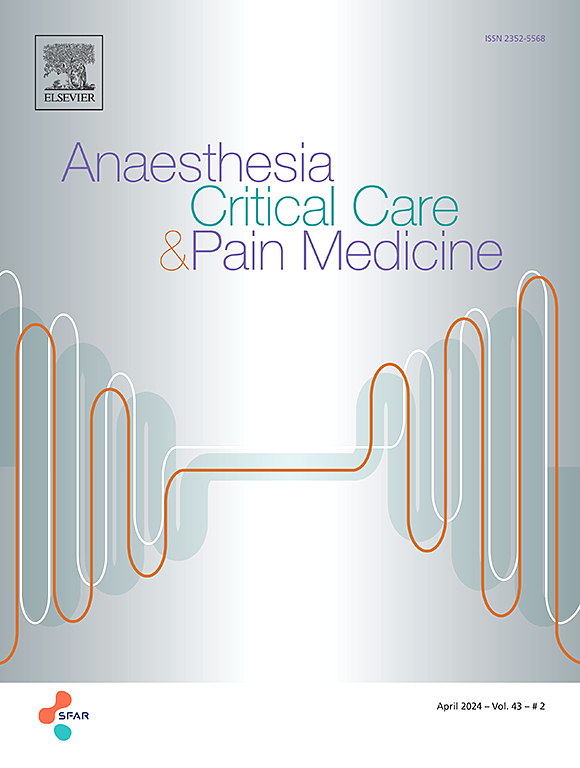Temporal stability of inflammatory subphenotypes of acute respiratory distress syndrome: 28-day insights from the ICAR trial
IF 4.7
3区 医学
Q1 ANESTHESIOLOGY
引用次数: 0
Abstract
Background
International guidelines have emphasized the necessity of evaluating the temporal stability of acute respiratory distress syndrome (ARDS) subphenotypes. This study aimed to assess the temporal stability of subphenotypes of ARDS over 28 days.
Methods
A reanalysis of a randomized trial was conducted, including patients with COVID-19-related moderate-to-severe ARDS across 43 centers. A K-means clustering was conducted to identify subphenotypes at 7-day intervals from inclusion to day 28. A Bayesian discrete-time Markov model was constructed to assess the temporal stability of subphenotypes.
Results
Two subphenotypes were identified among 146 patients. At inclusion, 121 (83%) patients were in the hypoinflammatory subphenotype and 25 (17%) in the hyperinflammatory subphenotype. The hyperinflammatory subphenotype was associated with higher rates of organ failure, higher plasma levels of cytokines, chemokines, adhesion molecules, and proangiogenic factors, and lower endothelial stability than the hypoinflammatory subphenotype. The hyperinflammatory subphenotype was associated with higher 28-day mortality (13/25, 52% vs. 30/121, 25%, p = 0.001) and fewer ventilatory-free-days through day 28 (p < 0.01) than the hypoinflammatory subphenotype. In the Bayesian Markov model, over 7-day intervals, patients in the hypoinflammatory subphenotype had a higher probability of remaining hypoinflammatory (70%) or being extubated (17%) than of progressing to the hyperinflammatory subphenotype (7%). Inversely, patients in the hyperinflammatory subphenotype had a higher probability of remaining in the hyperinflammatory subphenotype (52%) or dying (23%) than of transitioning to the hypoinflammatory subphenotype (20%) or being extubated (5%).
Conclusions
Inflammatory subphenotypes were stable in COVID-19-related ARDS, with few transitions over 28 days. Monitoring these subphenotypes could be valuable for assessing patient trajectories and treatment responses.
急性呼吸窘迫综合征炎症亚表型的时间稳定性:来自ICAR试验的28天见解
背景:国际指南强调评估急性呼吸窘迫综合征(ARDS)亚表型的时间稳定性的必要性。本研究旨在评估ARDS亚表型在28天内的时间稳定性。方法:对一项随机试验进行再分析,纳入43个中心的covid -19相关中重度ARDS患者。从纳入到第28天,每隔7天进行k均值聚类以确定亚表型。构建贝叶斯离散时间马尔可夫模型来评估亚表型的时间稳定性。结果:146例患者中鉴定出两种亚表型。纳入时,121例(83%)患者属于低炎症亚表型,25例(17%)患者属于高炎症亚表型。与低炎症亚表型相比,高炎症亚表型与更高的器官衰竭率、更高的血浆细胞因子、趋化因子、粘附分子和促血管生成因子水平以及更低的内皮稳定性相关。高炎症亚表型与较高的28天死亡率(13/ 25,52% vs. 30/ 121,25%, p = 0.001)和较少的无通气天数相关(p结论:炎症亚表型在covid -19相关ARDS中稳定,在28天内很少发生转变。监测这些亚表型对于评估患者轨迹和治疗反应可能是有价值的。
本文章由计算机程序翻译,如有差异,请以英文原文为准。
求助全文
约1分钟内获得全文
求助全文
来源期刊

Anaesthesia Critical Care & Pain Medicine
ANESTHESIOLOGY-
CiteScore
6.70
自引率
5.50%
发文量
150
审稿时长
18 days
期刊介绍:
Anaesthesia, Critical Care & Pain Medicine (formerly Annales Françaises d''Anesthésie et de Réanimation) publishes in English the highest quality original material, both scientific and clinical, on all aspects of anaesthesia, critical care & pain medicine.
 求助内容:
求助内容: 应助结果提醒方式:
应助结果提醒方式:


